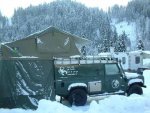You can make some modifications that will help a three season tent.
I sold my old Maggiolina to a fellow who had a very early Hannibal Tent. He wanted a better "cold" weather tent. While I think a Maggiolina to be good cold weather tent out of the box there is a lot you can do to make a standard tent handle the cold better.
The first thing that bothered this fellow with the Hannibal was that water would condense on the tent poles and drip all night long. There is an easy remedy, you can simply sleeve the poles with fabric adding some insulation to kill that condensation.
The second problem was he didn't think the Hannibal breathed well enough, hence the condensation. The four season mountaineering tents I've used a long time ago were double walled. They used a waterproof awning or fly to shed the snow, wind and moisture. The inner layer of fabric, really the tent itself would be more for controlling air and warmth. If conditions were really nasty, we would assemble the poles and awning first and then under its protection, the tent part. In essence, they were two tents.
The old Maggiolina "Adventure" I had was a little different from the new ones. I had what they called a "winter hood" very thin waterproof fabric that went around the sidewalls , the top being fiberglass and insulated, didn't need it. The difference was the way it attached. You first installed a velcro strip to the inner lip of the drip rail of the roof. The the winter hood would fit to that, kind of backwards, with the velcro out to attach to the inner drip rail. When you tightened the drawstring under the tent, the winter hood would tighten up and you would have a little more than an inch of separation between the waterproof outer fabric and the breathable inner fabric. It was confusing, the new Maggiolinas use a much more straightforward system. The concept is the same, to separate the the fabrics so they perform better. I would think you could do this to just about any tent and make it better for cold weather.



